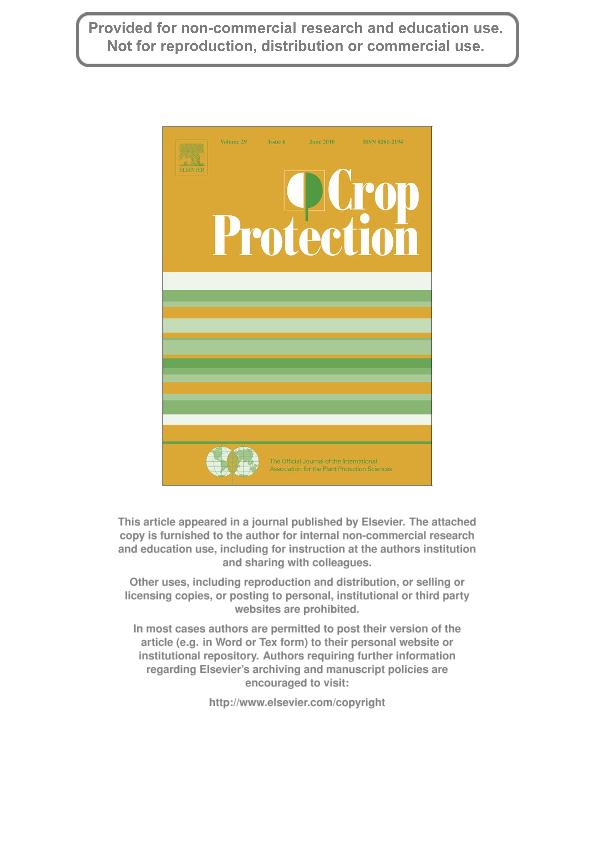Mostrar el registro sencillo del ítem
dc.contributor.author
Virla, Eduardo Gabriel

dc.contributor.author
Casuso, Macarena
dc.contributor.author
Frias, Eduardo Angel

dc.date.available
2018-04-10T15:18:09Z
dc.date.issued
2010-06
dc.identifier.citation
Virla, Eduardo Gabriel; Casuso, Macarena; Frias, Eduardo Angel; A preliminary study on the effects of a transgenic corn event on the non-target pest Dalbulus maidis (Hemiptera: Cicadellidae); Elsevier; Crop Protection; 29; 6; 6-2010; 635-638
dc.identifier.issn
0261-2194
dc.identifier.uri
http://hdl.handle.net/11336/41493
dc.description.abstract
The inclusion of the cry gene in corn may produce direct effects on non-target pests. Our research was focused on the relationship between Bt corn germplasm, expressing the cry1F protein to control the fall armyworm [Spodoptera frugiperda (Noctuidae)], and a non-target pest, the corn leafhopper [Dalbulus maidis (Cicadellidae)]. The aim of this contribution was to elucidate if Bt corn plants have influence on the oviposition preference of the leafhopper and to evaluate the effect of the transgenic plant on the hatching rate of egg. Female corn leafhoppers were released in cages each containing two potted plants in the V2 stage: a Bt germplasm and the corresponding isogenic hybrid. Laid eggs were counted and the number of hatched nymphs recorded. D. maidis females oviposited and laid more eggs in Bt plants. The egg hatching rate was negatively affected by the Bt germplasm. In addition, a field study was conducted in order to determine the abundance of D. maidis adults in Bt corn and the corresponding non-Bt isoline. Two corn plots sown with the same germplasms as used in the laboratory bioassays were sampled weekly. In the field, the population of the corn leafhopper was higher in the Bt corn plot than in the non-Bt isoline. Possible hypotheses for the differences in abundance of the vector in the field are: a) that pleiotropic effects of Bt corn could attract adults; b) the existence of a possible direct competition between the corn leafhopper and the target pest in order to utilize the whorls of corn plants as refuge and feeding sites, so the high populations of the vector could be due to the large supply of healthy whorls in the transgenic plot; and/or c) a differential attack of natural enemies occurring in non-Bt plots.
dc.format
application/pdf
dc.language.iso
eng
dc.publisher
Elsevier

dc.rights
info:eu-repo/semantics/openAccess
dc.rights.uri
https://creativecommons.org/licenses/by-nc-sa/2.5/ar/
dc.subject
Spodoptera Frugiperda
dc.subject
Oviposition
dc.subject
Abundance
dc.subject
Bt Corn
dc.subject
Cry 1f
dc.subject
Vector
dc.subject.classification
Otras Ciencias Biológicas

dc.subject.classification
Ciencias Biológicas

dc.subject.classification
CIENCIAS NATURALES Y EXACTAS

dc.title
A preliminary study on the effects of a transgenic corn event on the non-target pest Dalbulus maidis (Hemiptera: Cicadellidae)
dc.type
info:eu-repo/semantics/article
dc.type
info:ar-repo/semantics/artículo
dc.type
info:eu-repo/semantics/publishedVersion
dc.date.updated
2018-04-03T21:10:04Z
dc.journal.volume
29
dc.journal.number
6
dc.journal.pagination
635-638
dc.journal.pais
Países Bajos

dc.journal.ciudad
Amsterdam
dc.description.fil
Fil: Virla, Eduardo Gabriel. Consejo Nacional de Investigaciones Científicas y Técnicas. Centro Científico Tecnológico Conicet - Tucumán. Planta Piloto de Procesos Industriales Microbiológicos; Argentina
dc.description.fil
Fil: Casuso, Macarena. Instituto Nacional de Tecnología Agropecuaria. Centro Regional Chaco-Formosa. Estación Experimental Agropecuaria Las Breñas; Argentina
dc.description.fil
Fil: Frias, Eduardo Angel. Consejo Nacional de Investigaciones Científicas y Técnicas. Centro Científico Tecnológico Conicet - Tucumán. Planta Piloto de Procesos Industriales Microbiológicos; Argentina
dc.journal.title
Crop Protection

dc.relation.alternativeid
info:eu-repo/semantics/altIdentifier/doi/http://dx.doi.org/10.1016/j.cropro.2009.12.019
dc.relation.alternativeid
info:eu-repo/semantics/altIdentifier/url/https://www.sciencedirect.com/science/article/pii/S0261219409003305
Archivos asociados
